The next groundbreaking clean tech solution might just be brewing in Wisconsin. WARF is at the forefront, advancing cutting-edge projects from the University of Wisconsin-Madison that address today’s critical environmental issues and lay the foundation for a greener, more sustainable future.
Revolutionizing plastic recycling
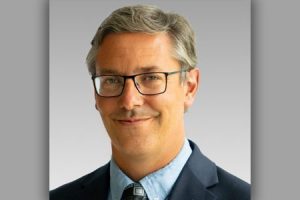 UW-Madison Professor George Huber aims to fundamentally change the way certain plastics are recycled in the midst of what he calls the “plastic era.”
UW-Madison Professor George Huber aims to fundamentally change the way certain plastics are recycled in the midst of what he calls the “plastic era.”
“It has the chance to be a revolutionary process,” Huber said in an interview. “We use plastics for everything, but we really haven’t thought about the end-of-life use of most plastic material. While the main end-of-life use really is landfills in Wisconsin … plastics really are a resource that we can use to remake new materials.”
Most plastic products also include other additives such as dyes and films, and traditional mechanical recycling can struggle to separate these materials, Huber said. Even getting clean plastic bottles back from consumers can be a challenge, as they’re often contaminated with residues from food and other sources.
As an alternative, Huber has been working since 2019 on the STRAP technology, which stands for solvent-targeted recovery and precipitation, and received support from WARF Accelerator to fund the initial scale up of the process. The method can break down mixed plastic waste to recover high-quality pure plastic resins for use in other products. That gives it a “big advantage” over the standard method, he said, as it can even remove a common oxygen barrier coating used to keep food and beverages fresh.
In partnership with a company in Neenah called Amcor, Huber’s team has been honing this process to improve the clarity of its plastic end-product, which he says is already better than any comparable material on the market.
They’ve also designed and are building a pilot reactor that can make 25 kilograms per hour of the plastic resin material at Michigan Tech University, with plans to begin production in 2025. After that plant is operational, they would then move to commercial applications, having proved its efficacy at the industrial scale.
“We’re doing everything we can to continue to develop the technology, pilot the technology and get it out to market,” he said. “And WARF’s been a great partner with this, they’ve helped us protect a lot of our inventions.”
Pyran’s innovative approach to renewable chemicals
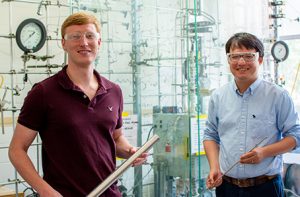
Renewable technologies are often more expensive than those that rely on fossil fuels, but a UW-Madison spinoff company called Pyran is defying this trend as it gears up for full-scale production.
This industrial chemical business was co-founded by UW-Madison Professor George Huber, and is backed by WARF Accelerator and WARF Ventures. It’s commercializing a new method for converting a low-value agricultural byproduct called furfural into 1,5-pentanediol, a valuable material that can replace petroleum-based 1,6-hexanediol in paints, nail polish, coatings, adhesives and certain plastics.
Furfural is made from inedible leftover plant crop materials like corn cobs, with about 600,000 tons of capacity available worldwide. By contrast, 1-5-PDO is produced in small amounts as a byproduct of the oil industry, but that process is relatively difficult, Huber explains.
“But we can make it from furfural very easily, we have a very efficient process to make it,” said Huber, who acts as a board advisor for the business.
Pyran has made dozens of barrels of 1-5-PDO already, and is working toward building a per year production plant as it conducts permitting and engineering planning and considers possible locations.
Huber says costs would become “really cheap” by integrating with feedstock production down the road, opening up possibilities for further uses of furfural in a range of other products. Huber calls Pyran a “key intermediate” for this progression.
“We’re going to take agricultural products, and turn them into valuable chemicals,” he said. “This is critical for agriculture, we need to make more products from our agricultural resources … and I think it’s very important as well for economic development, especially rural economic development.”
Minimizing dependence on synthetic nitrogen fertilizers
 Jean-Michel Ane, UW-Madison professor of bacteriology, wants to bring scientific rigor and certainty to the field of nitrogen fixation, which he says has been tainted by hype and exaggeration.
Jean-Michel Ane, UW-Madison professor of bacteriology, wants to bring scientific rigor and certainty to the field of nitrogen fixation, which he says has been tainted by hype and exaggeration.
He’s working on several approaches using altered microbes and plants to reduce reliance on synthetic nitrogen-containing fertilizers, which sustain crops for half the world’s population. Because their use has led to downstream environmental consequences, efforts have been made to limit these impacts over the past century.
“Even right now, you have several companies selling bacteria that supposedly give nitrogen to plants, and they have little solid data to support their claim,” he said. “There is a lot of snake oil in my field. And that hurts really bad, it hurts the trust that growers but also sometimes even scientists have for the benefits that we can get from these approaches.”
In hopes of restoring trust in the field while also addressing environmental concerns, Ane has created modified forms of bacteria that provide much more nitrogen to their host plants in exchange for sugars from photosynthesis.
Through genetic manipulation, Ane has largely removed the microbes’ “brakes” that limit this process of nitrogen fixation, forcing them to absorb much more than their unaltered counterparts. That means less artificial fertilizers are needed. But because this reduces the microbes’ ability to persist in the environment, the trick has been to find a balance between these changes and survivability.
While development continues on the microbe side, Ane is also pursuing ways to alter the plants themselves to be better hosts for the nitrogen-fixing bacteria. That includes taking structures that naturally occur in some tropical plants and causing them to be expressed in others that are grown in this part of the world.
Eavesdropping on insects
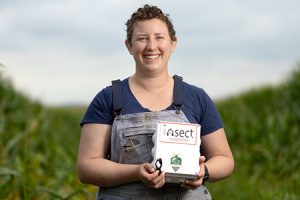 The inventor of a device that can identify insect activity on farm fields hopes to enable more efficient and sustainable agricultural practices.
The inventor of a device that can identify insect activity on farm fields hopes to enable more efficient and sustainable agricultural practices.
Emily Bick is an assistant professor of precision pest ecology at UW-Madison, and an Extension specialist for field and forage crops. Her device, called the Insect Eavesdropper, uses an inexpensive contact microphone and a machine-learning algorithm to identify infestations.
This “ultra-sensitive” specialized device doesn’t pick up airwaves like a typical microphone. Instead, it senses vibrations made by insects feeding on plants, recording electrical impulses that can be decoded into “sounds.”
“This is the same type of microphone that the CIA, or spy agencies use to listen into conversations through walls,” she said. “Where they use the wall as a way to amplify and then some algorithms afterwards to clarify the sound.”
Using sophisticated data analysis, scientists in the Bick lab can estimate the number or density of insects in a given area without relying on the standard techniques currently used for this purpose. These can include trapping the bugs with sticky pads or specialized nets, or taking a machete to the plant itself to look inside for insect invaders.
Since creating the technology, Bick’s team has sent it to more than a dozen peers for field testing, participated in multiple business idea contests and raised nearly $1 million in public, competitive grants, as well as support from WARF Accelerator. She plans to launch a startup company around the device, and is working with WARF on that process.
Early customer discovery has uncovered two main groups that may be interested, she said. Farmers themselves could use the Insect Eavesdropper to see how well their insecticides are working, and crop consultants or academic groups could use them to identify “problem insects” at the regional level.
“We’re hoping that this is actually one major sensor that would enable more precision actions, more sustainable farming, which allows for better protection of biodiversity, of all the other insects in the system that are not actually pests,” she said.
Harnessing plant power
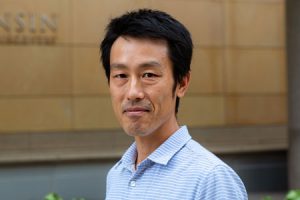 UW-Madison’s Maeda lab has identified a plant mutation that could be key to disrupting fossil fuel-reliant chemical synthesis industries.
UW-Madison’s Maeda lab has identified a plant mutation that could be key to disrupting fossil fuel-reliant chemical synthesis industries.
Hiroshi Maeda, a botany professor at the university, says there’s a big opportunity to use plants as a chemical production platform, replacing petroleum-based production of aromatic compounds. These chemicals are widely used in consumer products, ranging from plastics to food and medicines, Maeda said in an interview.
“Many of these aromatic chemicals are currently extracted from fossil fuels, and that leads to their quite substantial contribution to global warming,” he said.
His work in this area began about 13 years ago when he first came to UW-Madison, exploring metabolic pathways within plants that convert sugars and other carbohydrates into these aromatic chemicals. Most approaches failed. But about five years ago, after inserting various mutations into test plants, the team found one that “accumulated really high levels” of the target compounds.
Since identifying the mutation responsible for this “drastic change” in chemical metabolism, his team has been testing if it can achieve the same result in other plants. With support from the WARF Accelerator program, they successfully demonstrated the same effect in soybean plants and are conducting further analysis.
As an added benefit, Maeda notes the mutation could result in the soybeans being more nutritious due to having higher levels of aromatic chemicals. And importantly, the altered plants that are producing more of these compounds are also capturing up to 30% more carbon dioxide to support that process.
“That’s another trait that we are interested in … With a single mutation, we may be able to achieve two exciting results,” he said. “One is to make more useful aromatic chemicals. But at the same time, suck up more CO2 from the air, reducing CO2 concentration in the atmosphere.”
Breakthroughs in carbon capture
 A UW-Madison spinoff and WARF Ventures portfolio startup called Alithic is raising funds as company leaders gear up to launch a pilot plant in the coming years.
A UW-Madison spinoff and WARF Ventures portfolio startup called Alithic is raising funds as company leaders gear up to launch a pilot plant in the coming years.
The business is based on research from Bu Wang, an associate professor of civil and environmental engineering who leads the university’s Sustainable Materials Innovation Lab. He developed a way to use coal and steel waste to create a carbonated material that can be used in cement production, while also capturing carbon dioxide directly from the air as part of that process.
The company’s carbon capture to carbon-negative cement materials technology has been tested through a WARF Accelerator-backed project on campus. It has the potential to enable more efficient and less expensive CO2 removal while helping to offset the global cement industry’s considerable carbon footprint.
Now, under the direction of CEO Quentin Phillippe, Alithic is adding domain experts to its team and connecting with investors to fuel the next phase of development.
Greg Keenan, senior director of WARF Ventures and WARF Accelerator, says the team is “well on their way.”
“The company is successfully raising institutional investment, which is huge,” he said. “When you have a technology like this that’s able to raise institutional capital spinning right off campus, it’s remarkable and we love to see that.”
Investment funds will be used in designing the company’s pilot plant, which WARF expects will come online in 2025 or 2026. The company is already working with an engineering firm on that effort and identifying potential locations for the plant. Meanwhile, conversations are underway with potential customers in the cement industry as well as feedstock suppliers.
Advancing fusion energy
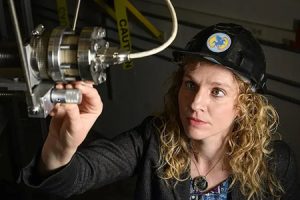 With support from WARF, fusion researcher Stephanie Diem is pioneering an innovative energy system design while also furthering representation of women in physics.
With support from WARF, fusion researcher Stephanie Diem is pioneering an innovative energy system design while also furthering representation of women in physics.
Diem is a professor of nuclear engineering and engineering physics at UW-Madison who leads the university’s Pegasus-III project – an effort to develop and test a device called a spherical tokamak machine. Tokamak devices, which use powerful magnetic fields to confine superhot plasma, are being developed in hopes of achieving controlled nuclear fusion.
While these machines are typically toroidal in shape – visually similar to a donut – Diem’s version of the technology is shaped like a sphere. This more dense design is meant to reduce the complexity associated with the donut-like shape and make it easier to engineer and control, according to WARF Ventures and WARF Accelerator Senior Director Greg Keenan.
“It’s really a very impressive piece of equipment,” he said.
Experiments with the spherical tokamak began in 2023 at UW-Madison with funding from the U.S. Department of Energy, following a nearly three-year construction phase that involved assembling thousands of complex components. It’s now being used to study plasma physics interactions, playing a key role in advancing this field.
Fusion energy and physics more broadly is a traditionally male-dominated field, but Diem’s lab employs multiple “amazing” female scientists, Keenan noted.
“Depending on how you count the fusion space, in terms of researchers, her lab has two to five percent of all women who are working in fusion, which is awesome,” he said. “She’s able to attract these world-class scientists, in some cases because they want to work for a woman researcher, who is amazing.”
Other climate-centric research connected to UW-Madison
Whitney Loo is the Conway Assistant Professor in chemical and biological engineering, where she draws on her background in studying the physics behind lithium battery components and researching nano-scale patterning to develop advanced polymer technologies. These include new sustainable materials made from sustainable feedstock and energy storage devices.
Juliana Pacheco Duarte, an assistant professor in engineering physics, is conducting research on advanced nuclear reactors in Madison after spending time at Virginia Tech’s nuclear engineering program and working on a nuclear propulsion reactor in Brazil. Her work centers on safety and analyzing fluids under the influence of heat, delivering insights for nuclear reactors that are cooled and moderated by water.
Fang Liu is an assistant professor in UW-Madison’s College of Engineering, where she aims to advance materials and energy technologies to address sustainability and related challenges. Ranging from heavy-duty batteries for the transportation sector to grid-scale energy storage and large-scale carbon dioxide capture, her work has been published in more than a dozen scientific journals and publications.
Pavana Prabhakar leads the university’s Manufacturing and Mechanics Lab through positions in civil and environmental engineering and mechanical engineering, developing sturdy but lightweight composite materials for aircrafts, marine vessels and other applications. To better understand how these materials behave in various environments and design new alternatives, the lab conducts both experimental and computational research.
Line Roald is a Grainger Institute Fellow and associate professor in electrical & computer engineering, whose research aims to responsibly drive the transition to a more sustainable and resilient energy system. She’s working to create new software and modeling tools for various players in the energy market using real-world data, in hopes of effectively integrating more renewable resources into the energy grid.
Katherine McMahon, a professor of bacteriology and civil and environmental engineering at UW-Madison, researches the microbe-level ecology of natural and engineered systems in hopes of better understanding microbial behavior. At the McMahon lab, she and her students seek to improve scientists’ ability to predict and model how microbes interact with their environment, while advancing engineering applications for these miniscule lifeforms.
WARF has a broad and deep portfolio of biorenewable technologies based on groundbreaking UW-Madison research, ranging from methods for modifying plants to produce more useful materials to new ways of synthesizing valuable chemicals from biomass and much more. These innovations come from researchers across a wide array of specialty fields, including agricultural sciences and engineering. The university’s Great Lakes Bioenergy Research Center, Wisconsin Energy Institute and Wisconsin Crop Innovation Center all play a role in advancing this field of study.
UW-Madison spinoff company Realta Fusion has an audacious goal: building a commercial fusion reactor, which has the potential to revolutionize the way electrical power is generated and help offset the environmental impacts of fossil fuels. This goal is part of the company’s long-term plan, with initial stages focused on applying the technology to industrial heat and power applications. Thanks to funding from UW-Madison and WARF Ventures and Accelerator, the company continues to develop its technology and advance its objectives, recently announcing a “major milestone” toward commercial applications of nuclear fusion.
Silatronix is developing advanced materials to improve the performance of lithium-ion batteries after spinning off from the research of UW-Madison Profs. Robert West and Robert Hamers with support from WARF Ventures. It has specialized in patented organosilicon materials, offering greater storage life and capacity along with operating in a wider range of temperatures. Since being acquired in 2021 by Orbia Fluor & Energy Materials – which does business under the name Koura – Silatronix now operates as a “technical center of excellence” within the company’s battery materials group.
Interested in learning more?
Contact Michael Carey at [email protected], 608-960-9867.
